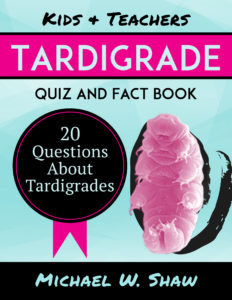Are you interested in tardigrades? Despite their popularity on the internet, there isn’t a lot of good information about these fascinating creatures all in one place – until now.
Perhaps you’ve already started searching for tardigrades, or you would like to hunt for them. Or maybe you simply have an interest in learning more about tardigrades.
Now there is an easy way to get all the facts.
The Kids and Teachers
Tardigrade Quiz and Fact Book
If you are a parent, your child will have the makings of a good science fair project. If you are a teacher, you will be able inform your students, and create your own amusing quizzes like this crossword puzzle. (Download it from my website – link at the bottom of this page.)
What are tardigrades?
Where do they live?
What temperatures can they withstand?
Can they really survive the vacuum of space?
You don’t need to do a time-consuming web search to find the answers. They are all in this book, and you can cite the book as your reference source when doing a report, a project or paper.
The Tardigrade Quiz and Fact Book is structured to help you learn.
Whether you buy the paperback version or the Kindle book, you will find that learning is fun because of the quiz format. Did you know that when you do a quiz it helps your memory retain information? And the pictures reinforce your ability to recall the answers.
You are a parent. Imagine your son or daughter explaining their science fair project to a judge at the science fair with confidence because they really do know all about tardigrades. Think of your child’s conversations with friends and family who will be impressed and want to hear more. Their questions will not be simply about tardigrades but about your child, such as “How did you get interested in tardigrades?” “Did you ever see one?” “Do you have any as pets right now?” Your child’s classmates will want to come over to your house and see a tardigrade! Have the cookies and milk ready!
You are a teacher. Don’t be surprised if colleagues ask you to visit their classrooms and give talks. Can you imagine a parent’s pride when their kid comes home using words like “Fahrenheit, spore, and ultraviolet radiation?”
FACT: “Students are more likely to remember information that is learned with a visual aid.”
Beeland, W. “Student Engagement, Visual Learning, and Technology: Can Interactive Whiteboards Help?” (2001).
FACT: “Words are abstract and rather difficult for the brain to retain, whereas visuals are concrete and, as such, more easily remembered.”
http://www.psychologytoday.com/blog/get-psyched/201207/learning-through-visuals
FACT: Quizzes help students remember more easily: “… it requires students to retrieve information from memory, and such effortful retrieval turns out to be a wonderfully powerful mnemonic device in many circumstances.”
Benefits of testing memory: Best practices and boundary conditions. Roediger III, Henry L.; Agarwal, Pooja K.; Kang, Sean H. K.; Marsh, Elizabeth J. Davies, Graham M. (Ed); Wright, Daniel B. (Ed), (2010).
TESTIMONIALS and REVIEWS
“I love the idea of building a quiz into a science book like this. The reader is asked a question, if they get it right they get a detailed explanation of why they are right. If they should happen to get it wrong, the author will either throw in a funny joke or offer additional information to help the reader reconsider their answer. I think this is a great way for kids and adults to learn new content.”
J McCullen
“I gave this a five star rating because of the information presented. I had no idea Tardigrades were so resilient. Just as suggested by the author, the answers can be very funny yet remain informative. The facts are presented in an entertaining way. Don’t be surprised if your kids laugh out loud. If you read any books this year this one must be among them.”
Dan Holloway
“What a nice little book on Tardigrades, I just bought it and my Granddaughter (7) is already going through it and asking questions. Definitely a little book for Teachers and Kids.”
Thank you Mr. Shaw.
Reynald Carra
Did you know?
– Tardigrades have a respiratory system and a nervous system
– Tardigrades survive in extreme conditions like minus 200 Centigrade
– The tardigrade can be dehydrated and re-hydrated decades later
– There are some very strange shapes of tardigrade eggs
Be sure to check out the author’s YouTube video called “First Animal to Survive in Space.” You will see why this video about tardigrades had over 10 million views in its first week,
